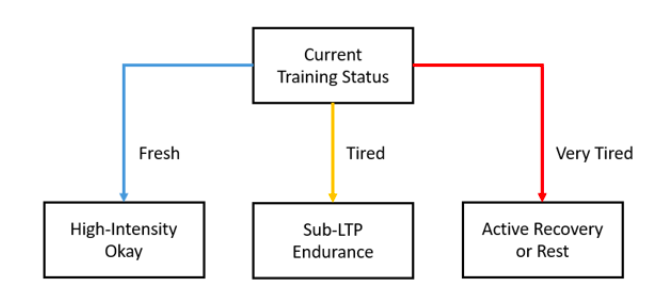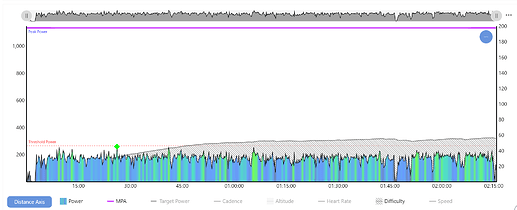Great article to better understand Xert as a Xert newbie!
Great article . Just slightly confused about one thing.

This for me when tired: Not one recommended workout with intervals sub LTP
Hi Cary - great catch. We can update the post.
EDIT: When training status is Yellow, Xert will recommend Endurance workouts that are below 2.5 difficulty rating. An exact 2.5 difficulty rating corresponds to riding exactly at LTP for some time. So the workout recommendations may have intervals above LTP (or even TP), as long as they are sufficiently low in overall difficulty.
There’s also always the option to free-ride… You’ll notice that the interval ‘target’ when you’re yellow training status is equal to your LTP. This is often how I handle my Yellow status days - free ride easy and keep the intensity below LTP. The resulting activity ends up looking something like this:
Thanks for the article!
Is xert looking at the possibility of importing data from wearables to advise ATA?
I’ve been wearing an OURA ring for a couple years now it’s been very educational and a great help with dialing in my sleep and recovery habits.
For the most part the readiness score is pretty accurate with how I’m feeling but I never let it determine at what intensity I train on any given day, I ALWAYS listen to my body and select my workouts accordingly.
I would welcome connecting my oura ring data to xert. That would be pretty cool!
I think this is why no HRV or recovery products have been incorporated directly into Xert yet. While those devices can be helpful for us to make informed decisions about our training, we certainly want to avoid situations where you feel you have to do what Oura or Xert says.
There’s a reason that we’ve provided the tools to allow you to override Xert’s training status calculation with the FF Slider, as well as being able to filter the workout recommendations. You should be taking advantage of those tools! They can be used along with your subjective feelings & HRV/Recovery data to take your adaptive training to a whole new level!
Useful article overall, so thanks
I didn’t spot it in the article but another useful check for recovery is HR response during the warm up and / or early intervals. If HR is significantly higher OR lower than usual for the same effort (warm up, or interval), it could be a sign of fatigue or even pending illness. I’ve heard many interpret the lower HR response as a sign of improved fitness, but when it’s acute (rather than a much longer term trend of lower HR for the same power) it’s usually a sign you need a rest. I mention as I recently experienced that despite normal resting HR and HRV after some heavy training and under-recovery.
The other thing I note is use of ‘recommended workout’ - the article explains that it is not necessarily recommending you train, but that is exactly what ‘recommended’ means (put forward with approval as being suitable)… perhaps ‘suggested’ (put forward for consideration) is better, but perhaps still too strong… it’s maybe too wordy, but it’s really ‘if you want to train and freshness reflects how you feel, we’d suggest…’ so that it’s even clearer you need to consider multiple things.
I would also suggest changing the labels for the colors. Yellow is just ‘high intensity systems fatigued’ rather than the more general ‘tired’ and would cause much less confusion. Loads of people don’t realize that it just means train low intensity, but as long as you like. It’s explained well in the article, but how many new users will read it before jumping into using the system…
I’ve been thinking about this and I think a traffic light style system would be easier to follow/understand. Red for example is recovery only as all systems are tired or a massive excess of low strain, amber would be the warning to stay away from high intensity, endurance only and preferably below LTP if time allows, with green you would get the green light for high intensity workouts. I’m not sure what the current difference is between blue and green for example or even if we need Xert to show us that difference. Completely agree that the current Yellow status and the word ‘tired’ is confusing for people, especially people who are new to Xert.

